“SEO audits are a waste of time.” That one hurts to read, doesn’t it?
Recently, I came across a LinkedIn post that lamented on SEO audits. My comment got a lot of engagement, so the idea for this article was born:
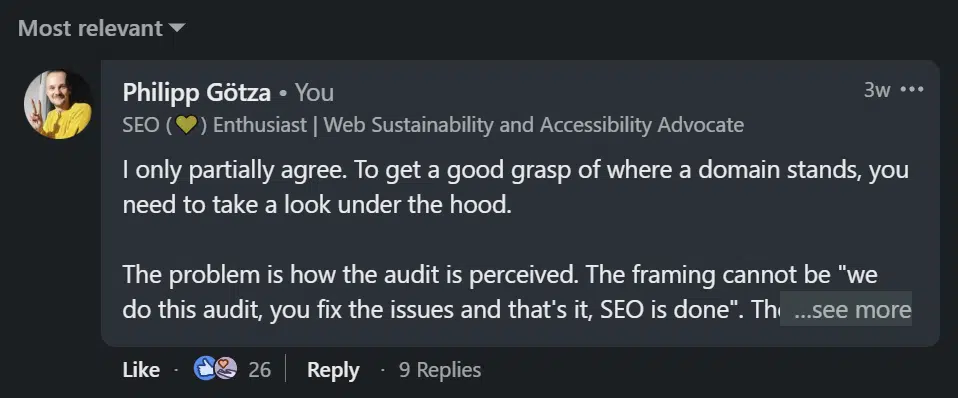
There are good arguments why you could say that audits are indeed a waste of time, but this cannot be generalized. It’s more an issue of both doing the audit and selling it the wrong way, which is the root cause of the perception that “SEO audits are a waste of time.”
This is not a tactical guide to creating a great SEO audit. There are enough of those already.
However, after reading this, you will have a much better idea of how to deliver great SEO audits, regardless of whether you are working in-house, in an agency or as a consultant.
Why we must do SEO audits
Before we dive into the problems with SEO audits and what you can do about them, I would like to provide three arguments for why we need them.
An SEO audit helps you get up to speed and acts as a diagnosis
Working with a new client or landing a new in-house role means you are completely new to a domain. Especially if no SEO team has a deep understanding of what you are dealing with, an SEO audit will help you to get up to speed.
You will uncover the biggest construction sites and the biggest growth opportunities. You want to know about the status quo. Here’s a practical example from my SEO consulting:
- A client lost several times due to Google algorithm updates.
- There were solely assumptions on why the traffic dropped.
- Before we did change anything, we conducted an SEO audit.
- We uncovered a severe technical issue, resulting in a full duplicate of the domain (over 1 million pages).
- The issue was not hiding in plain sight, and the client hadn’t known about it before.
You cannot build a house on a shaky foundation. If you do, it’s like a house of cards, collapsing when a little wind blows.
In “Good Strategy, Bad Strategy,” Richard Rumelt says that good strategy contains three elements:
- A diagnosis.
- A guiding policy.
- Coherent action.
Without a diagnosis, you cannot reach a plan for coherent action. No coherent action means you are doing things aimlessly. This will lead to wasted resources, money and time.
The SEO audit is (part of) the diagnosis. It’s a chunk of the strategy, but only one (important) piece.
Repeat after me: An SEO audit is not an SEO strategy.
Dig deeper: 13 questions to diagnose and resolve declining organic traffic
Missing a plan for coherent action will lead to too little execution
One of the biggest issues in SEO is not having enough throughput. This is often a result of having the wrong idea of what to execute or insufficient resources.
Doing maintenance audits regularly is like getting your teeth or car checked out. A good dentist will not only check what might be broken and is going to fix it, but he will also give advice on how to prevent something from happening in the future.
The worst of all is if you go to a doctor who doesn’t do a good job of checking you out. You are prescribed medication, which lands you in the hospital or the cemetery. That is what doing SEO without direction, a proper plan of action and the wrong diagnosis can do to your website.
An SEO audit is a good anchor for orientation
This more or less goes hand in hand with the first two arguments: If you don’t know where exactly your problem is, you could focus on the wrong thing.
To elaborate further, let’s look at how search engines mostly work:
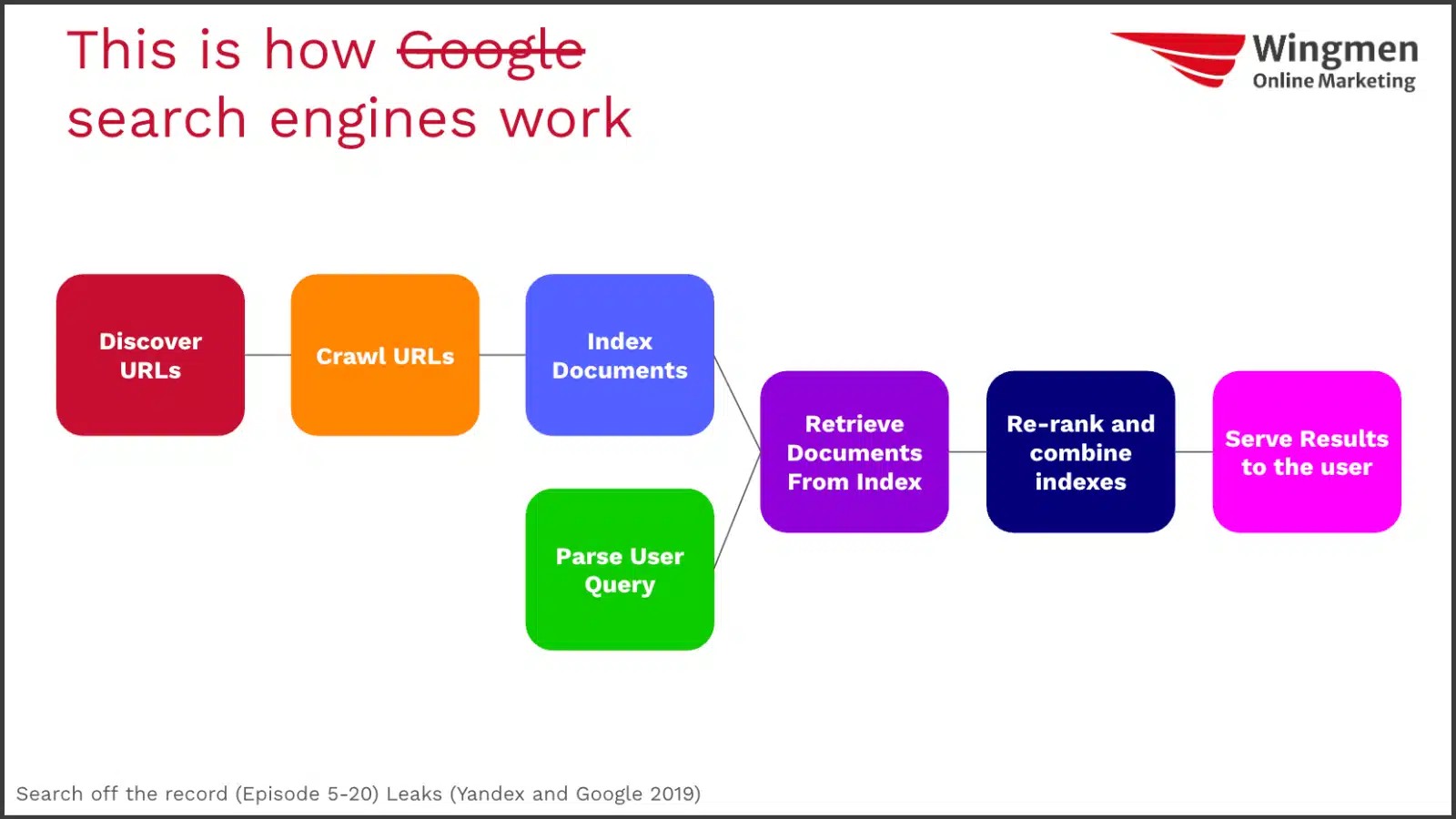
It’s a process of multiple steps. You can find issues in each, but since it’s a chain, it matters where issues or opportunities can be found. Working on ranking your documents better might be the wrong approach if your biggest issue is indexing.
You have to fix both in the long term, but the indexing part is holding everything else back in this example.
So, an SEO audit is an anchor for orientation. You will know where you stand and which direction you should go.
Dig deeper: The 4 stages of search all SEOs need to know
Get the daily newsletter search marketers rely on.
Why SEO audits are seen as a waste of time and how to fix them
Now, we will take a look at a few (other) problems that create the perception of “SEO audits being a waste of time.” Knowing these problems is good, but having the right solution is even better.
You will benefit from me making mistakes in the past. Always remember: Everybody starts somewhere.
Problem 1: Delivering a long list of issues without prioritization
This is problematic for multiple reasons:
- Having no prioritization often leads to distraction. You have a to-do list and will most likely focus on stuff that is easy to do so that you can tick it off the list.
- If you are not the one working with the audit but receiving it, a long, non-prioritized list will lead to cognitive overload.
To quote Rumelt again (emphasis mine):
“The diagnosis for the situation should replace the overwhelming complexity of reality with a simpler story, a story that calls attention to its crucial aspects.”
A long list without a clear focus is confusing and will get you nowhere.
Solution:
- Condense your audit and use frameworks for prioritization. Only list what’s actually moving the needle or is holding the project back. The rest can either go into an annex within the same document or into a separate document.
- To prioritize, you can use the ICE framework (popularized by Sean Ellis) or a matrix approach. Ultimately, it should be clear what must be done first.
- If it is a detailed audit of a large domain, use a table of contents and jump links for easy navigation. I like to include a table of recommendations to see everything on a high level quickly:
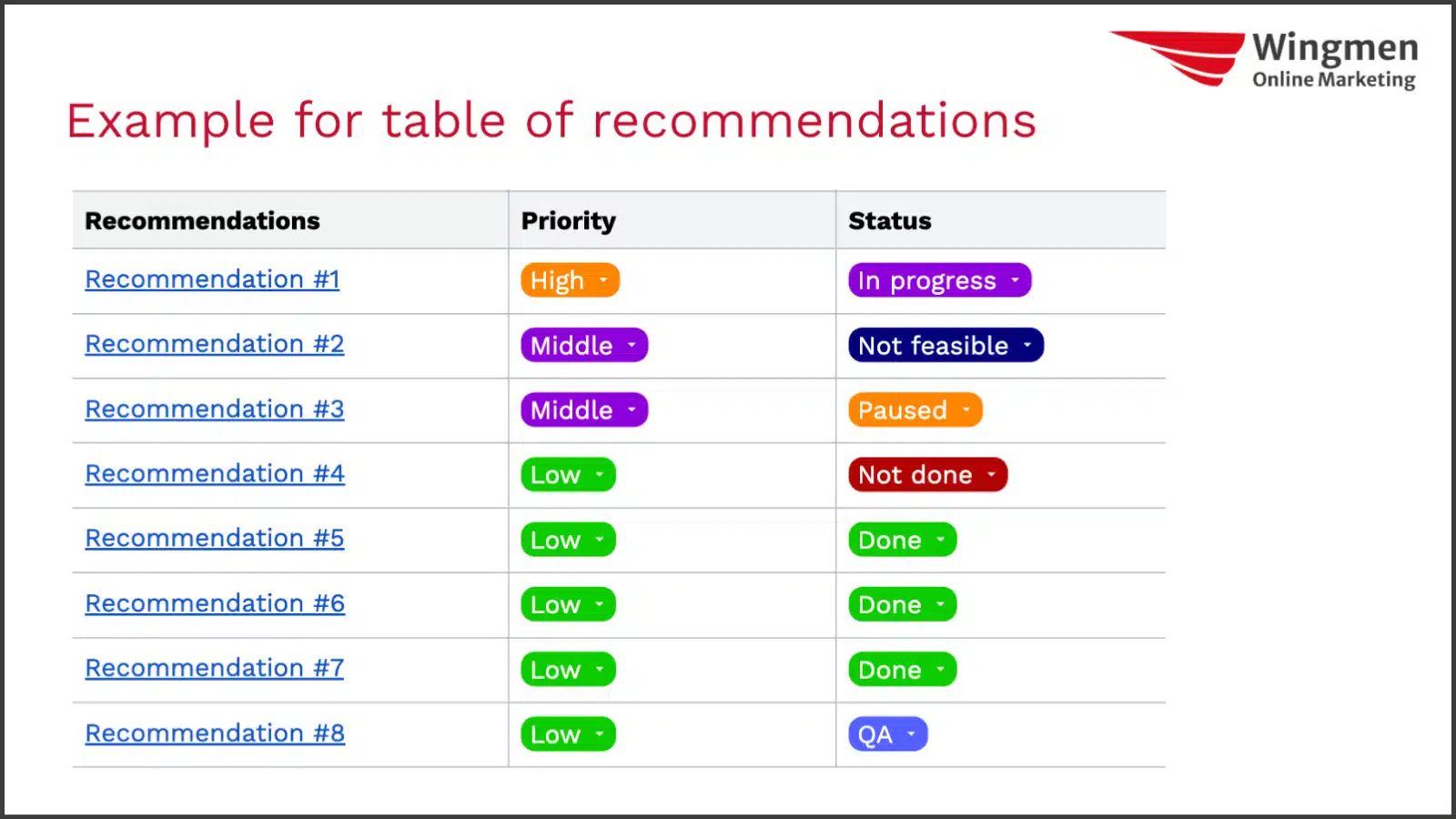
Dig deeper: How to make better SEO reports for the C-suite
Problem 2: Unclear, ambiguous and lazy recommendations
This is a major problem. It’s not just about identifying an issue or an opportunity. Sadly, when I examined audits of various agencies and consultants, they weren’t up to par.
Screenshots from tools and only delivering a list of issues is not an audit. It’s like asking ChatGPT to write a 500-word blog article. Everyone can do that.
The value of an audit doesn’t come from just finding issues/opportunities. It’s added value by having a plan of what to do, when and how. Having a JavaScript-dependent site is often not good for SEO, but a cookie-cutter suggestion like switching to server-side rendering is rarely feasible or the right thing to do.
Solution: Provide a clear and concise recommendation that is easy to follow.
Want more audit recommendations implemented? Make it easy. Here’s a simple example:
You found a lot of 4xx issues on a site:
- Bad: List the 4xx URLs.
- Good: Go a step further and provide a list with all links pointing to these pages.
- Better: Provide additional insights if these links are an editorial or a technical problem (number of links, their position, etc.).
Problem 3: Speaking the wrong language
Who will read the audit? An SEO, mostly a dev, the editorial team or some executive?
A common issue is reporting in a language that cannot be understood. Here are some examples:
- Too much jargon will make SEO seem like some magical hocus-pocus, distanced from business metrics and outcomes.
- Too much information will lead to confusion and cognitive overload – no one needs all the details.
What also falls in this category is the tone of your language. A lot of audits sound very negative.
Listing issues and headlines phrased as problems is a classic example – I’m doing it on purpose here. No one likes a person who is complaining all the time.
Solution:
- Adapt your output to the people receiving the audit. Always include an executive summary to get the main points across quickly (see Problem 1).
- To avoid the negative tone, make your headlines more actionable. Instead of speaking about a problem, trigger action with a “call-to-action-like” headline or opportunities. Or combine both of them.
Look at this example to avoid a negative tone:
- Bad: Insufficient keyword coverage.
- Good: Untapped keyword potential.
- Better: Capture existing search demand by covering unused keywords.
Problem 4: Focusing too much on fixing rather than improving and building
This one is from Aleyda Solis’s playbooks.
“We’re stuck at fixing, instead of building, which is how we actually achieve goals.”
Fixing (technical) issues is not the foundation of growth:
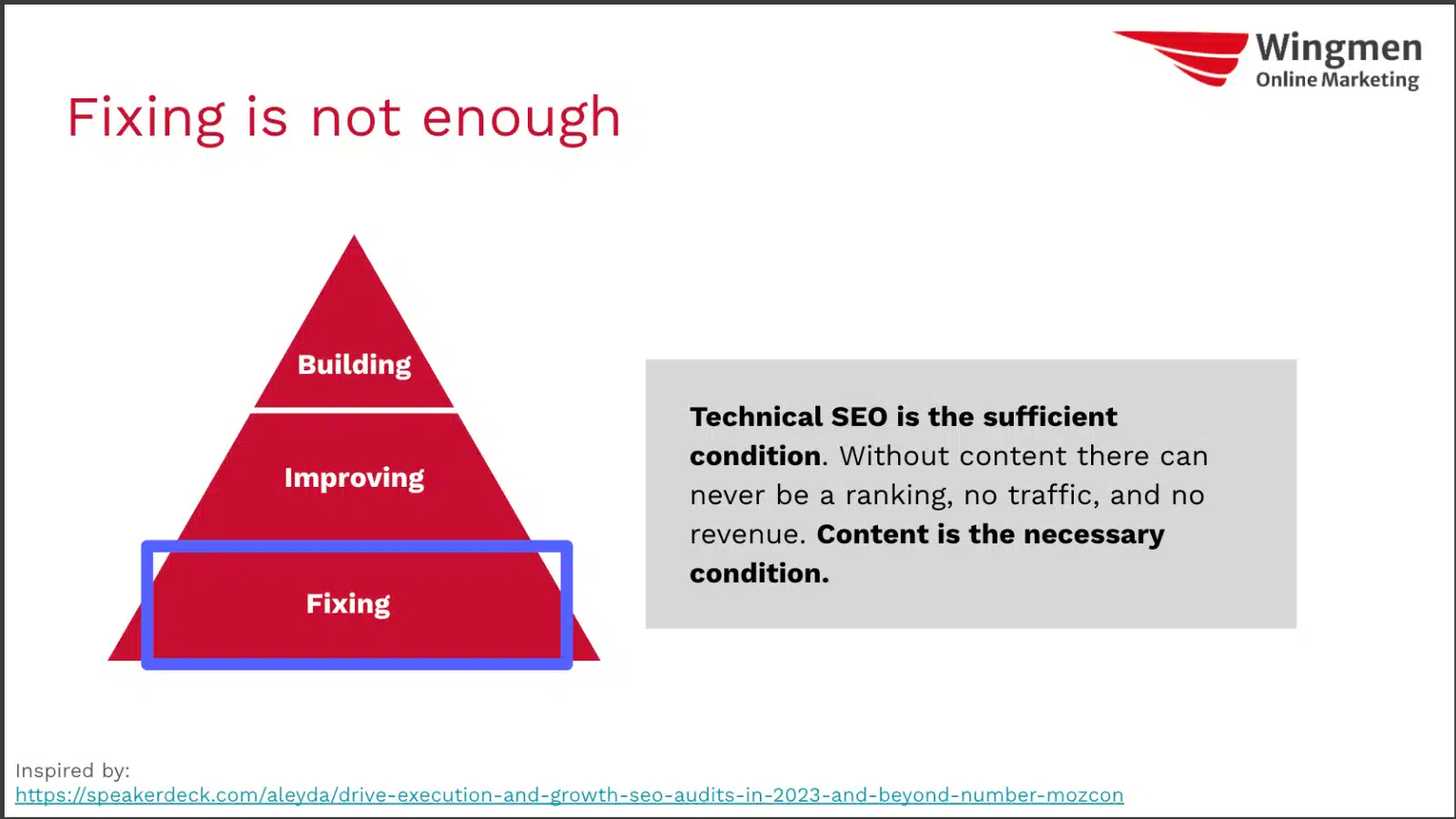
Solution: An audit must not only focus on fixing, but also improving and building.
That means:
One way to approach this is to go for low-hanging fruits first. What relevant content do you already have that is performing well (e.g., ranking on top 20)? You can easily check that with Google Search Console.
It’s much easier to improve existing content than it is to create new content. Also, improving existing content increases the relative amount of high-quality content of your domain.
Think about your website like a glass of wine.
Google wants pure wine (= high quality content, red), not water (= low quality content, blue). See the following visualization:
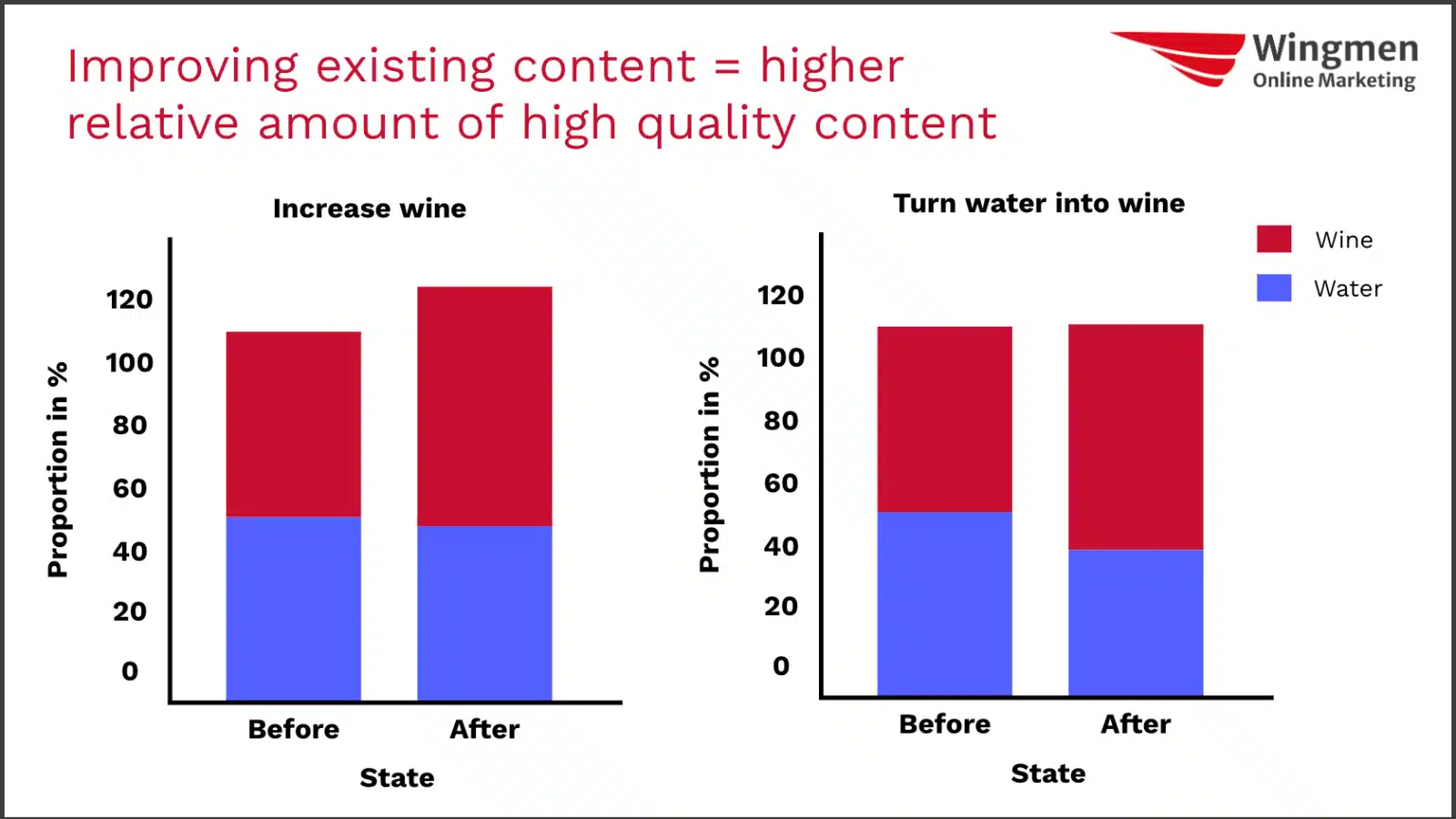
Dig deeper: What to look for in a technical SEO audit
Problem 5: The audit is not a solution in itself
This goes into the bucket of failing to communicate what an audit is or isn’t. An audit by itself is not going to do anything. We go back to the beginning – execution matters.
If your recommendations never find their way into practice, doing the audit will be considered a waste of time. Worst case: You get fired.
Solution: Communicate what an audit will do and what is necessary after the audit is conducted. Some other problems listed above are also reasons why SEO audit recommendations are often not being implemented.
Problem 6: Not finding out why there were issues in the first place
If this happens, the audit is disconnected from the processes that created the situation in the first place. This is where I agree with the LinkedIn post that sparked the idea for this article.
Typically, we are diving deep, finding issues and proposing solutions, which then (don’t) get implemented.
So far so good, right? Nope.
A year later, the same or similar issues arrive.
Solution: Find out why these problems happened in the first place. When you do, develop frameworks to avoid them in the future.
If you have a one-time project with a client or just started your new role, this is much harder than if you work together regularly or already have a business relationship.
For long-term client relationships or in-house SEOs, I recommend engaging in coming up with things like:
- Editorial guidelines featuring SEO aspects.
- Technical testing before recommendations are pushed to the live website.
- Evangelizing SEO in your company/for your client and raising awareness.
- Education for SEO inside the company.
Dig deeper: What your enterprise SEO audit may be missing
SEO audits done the right way are not a waste of time
One would see SEO audits as a waste of time because of the problems outlined above. There are many more you can probably think of as well.
However, there are solutions to all of those problems. Below is a quick checklist so you can deliver better audits in the future:
- Condense your audit and prioritize ruthlessly.
- Deliver disambiguate, clear and impactful recommendations.
- Speak a language everyone can understand.
- Don’t get stuck on only fixing – find ways to improve and build.
- Be transparent about what the audit is for.
- Find solutions to why problems existed in the first place.
It’s our responsibility to give SEO audits a better rep.
Done the right way, they aren’t a waste but a great use of time.
Opinions expressed in this article are those of the guest author and not necessarily Search Engine Land. Staff authors are listed here.
Related stories
New on Search Engine Land
